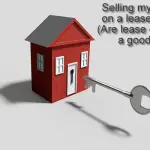
Property lease options are not easy to find, so when you find one it’s important to structure it in the right way.
So what are the key elements to structuring a lease option deal?
- Option fee or upfront payment: Necessary for a binding contract; the minimum is £1.
- Length of lease option agreement: Cannot exceed the remaining term on the mortgage.
- Monthly payment: Usually equals the mortgage payments.
- Purchase price: Amount paid for the property at some point over the lease option period.
It’s important when you’re negotiating the lease option to get each of the elements right. Your focus is to achieve a win-win between you and the property owner.
How do you structure a lease option deal to buy?
With that in mind, let’s take a look at each of the key elements to structure a lease option in more detail.
The option fee or upfront payment
In contract law one of the ways to form a binding contract is to include a payment or what’s referred to as consideration. Consideration is a concept of law that has been adopted in the UK. But it has also been adopted in the US and Australia too.
The minimum option fee or upfront payment in the UK is £1, but this would be $1 in both Australia and American of course.
Whilst the minimum payment of £1 or $1 is necessary to form a legally binding contract, the upfront payment (or option fee) needs to be an amount that works for the investor and the property owner to create the win-win scenario.
Your aim should be to make sure the option fee or deposit is no more than how much it would be if you were to buy the property in the normal way on a sale contract. But the amount paid has to be enough for the seller to be happy too.
If you’re not able to find a middle ground on the upfront payment, you’ll struggle to structure a lease option deal.
2. The length of the lease option agreement
The next important element to a lease option agreement is the length of the contract period.
The length of most lease option is usually between 3-5 years. But the period cannot exceed the term left on the seller’s mortgage. This is because the owner will have to repay their mortgage at the point it comes to an end. Which is unless the investor exercise their option to buy before the mortgage expires.
Otherwise the seller will be left with two alternatives:
- Sell the property to pay the mortgage off.
- Remortgage the property.
But my advise is that you never go into a lease option contract without the intention of exercising your option. Make sure to structure the deal in such a way that you will want to buy the property.
Often times the crucial element to this is the final purchase price (see point 4 below). If you get this wrong and the lease option contract includes a market price that is never reached, you won’t want to buy the property. But this is explained further in point 4.
3. Monthly payment in the lease option agreement
The monthly payment on a lease option is usually equal to what’s needed by the home owner to cover their mortgage payments. But it’s important to discuss this with the seller to get this right.
Also, if you are dealing with a person who is a higher rate tax payment in the UK, you need to consider the Section 24 Tenant Tax issue. Whilst it’s referred to as a lease option, the ‘lease’ element doesn’t have to be rent.
Remember to include a mechanism in the agreement when you’re structuring the lease option to take account if interest rates change during the term of the lease option contract.
4. Final purchase price
The final purchase price is the amount you’ll pay the owner at some point over the lease option period.
It is extremely important to get this right, especially if you follow my rules of integrity with lease options. As mentioned above, I advise that you never enter into an agreement of a lease option unless it is your intension to purchase the property.
This is best explained by way of an example.
Lease option example
Lease option example #1
In the first example, I’m, going to assume there’s a long time left of the mortgage term. Therefore, let’s assume the following information about the property owner:
- 4-bed property on the market at £225,000 but worth £195,000.
- Remaining mortgage £185,000; term left 23 years; mortgage payments £953.
- Property isn’t in Article 4 area and would rent as an HMO at £1,850 per month.
- Option fee £12,000; final payment £225,000; Option term 22 years; monthly payment £953.
The above lease option example takes into account the background information you would know from your negotiations with the vendor.
For example, you would know that they needed £12,000 to do what they are trying to achieve. Whilst this is more than the true current equity of £10,000, it’s less than how must you’d ordinarily pay as a deposit if this were a buy to let purchase.
This would be at least 15% or possibly 25% of the purchase price for the property. On the assumption you pay £195,000, the deposit would be somewhere between £29,250-£48,750 instead. Plus you’d have to find the stamp duty too.
Lease option example #2
In this first example, I’m, going to assume there’s only a few years left on the mortgage term. Therefore, let’s assume the following information about the property owner:
- 4-bed property on the market at £225,000 but worth £195,000.
- Remaining mortgage £185,000; term left 5 years; interest only mortgage £540.
- Property isn’t in Article 4 area and would rent as an HMO £1,850 per month.
- Option fee £5,000; final payment £185,000; Option term 4.5 years; monthly payment £540.
In this second example it would be unlikely that the property would reach the value of £225,000 in four and half years time. This would mean if you included £225,000 in the lease option contract, you would not want to exercise the option.
This is one of the lease option risks, but it’s more of a risk to the owner than the investor, as the investor has the right to buy, but not the obligation. You want to help the seller to think the lease option is a good idea, but coming with integrity.
This would leave the seller in a very bad position of either needing to remortgage or having to sell the property. Keep in mind always with lease options that you there to help people.
Entering into a contract you without the intention to ever exercise the option is not helping someone.
Therefore it’s very important when you’re structuing a lease option to consider what’s happening in the property market. Is the market in a down-turn or is it booming? For this you need to ask the following further questions:
- If the property market is in a down turn, will there be enough time before the end of the mortgage term for the market to recover again?
- If the market is booming, will the market price reach the price you set in the lease option agreement?
Structuring a lease option agreement for property portfolios
If you are structuring a deal with a portfolio of properties its important to structure it using separate lease option agreements for each property.
This is important to allow you to buy each property separately and to structure slightly differently depending on the mortgage term, property value and mortgage payment.
I hope you’ve got something from reading this article about how to structure a lease option to buy
If you’ve got something from this article about “how to structure a lease option to buy” please share it on your favourite social media site.
Also, if you have any questions, please feel free to comment below too. Alternatively, if you need more help, please feel free to contact us on our contact us page here. Or join the discussion and ask your question in the property forum.




